小学英语教研活动记录
- 格式:docx
- 大小:15.09 KB
- 文档页数:10
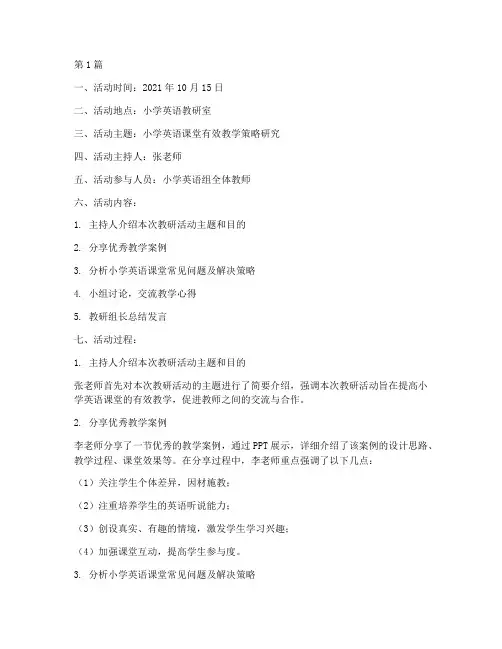
第1篇一、活动时间:2021年10月15日二、活动地点:小学英语教研室三、活动主题:小学英语课堂有效教学策略研究四、活动主持人:张老师五、活动参与人员:小学英语组全体教师六、活动内容:1. 主持人介绍本次教研活动主题和目的2. 分享优秀教学案例3. 分析小学英语课堂常见问题及解决策略4. 小组讨论,交流教学心得5. 教研组长总结发言七、活动过程:1. 主持人介绍本次教研活动主题和目的张老师首先对本次教研活动的主题进行了简要介绍,强调本次教研活动旨在提高小学英语课堂的有效教学,促进教师之间的交流与合作。
2. 分享优秀教学案例李老师分享了一节优秀的教学案例,通过PPT展示,详细介绍了该案例的设计思路、教学过程、课堂效果等。
在分享过程中,李老师重点强调了以下几点:(1)关注学生个体差异,因材施教;(2)注重培养学生的英语听说能力;(3)创设真实、有趣的情境,激发学生学习兴趣;(4)加强课堂互动,提高学生参与度。
3. 分析小学英语课堂常见问题及解决策略王老师针对小学英语课堂中常见的问题进行了分析,并提出了相应的解决策略。
以下是部分问题及策略:(1)问题:部分学生对英语学习缺乏兴趣。
解决策略:创设生动、有趣的课堂氛围,激发学生学习兴趣;关注学生个体差异,因材施教。
(2)问题:学生的英语听说能力较弱。
解决策略:加强课堂互动,提高学生参与度;利用多媒体资源,创设真实、有趣的情境;开展英语角、英语比赛等活动,提高学生的英语听说能力。
(3)问题:教师教学方式单一,课堂氛围沉闷。
解决策略:丰富教学手段,运用多种教学方法;关注学生的情感需求,营造轻松、愉快的课堂氛围。
4. 小组讨论,交流教学心得在主持人带领下,教师们分为四个小组,针对以上问题及解决策略进行讨论。
讨论过程中,教师们积极发言,分享自己的教学心得和经验。
以下是部分讨论内容:(1)教师A:在课堂上,我注重创设情境,让学生在真实语境中学习英语。
同时,我还利用多媒体资源,让学生在观看图片、视频等过程中,提高英语听说能力。
![小学英语教研组活动记录[5篇]](https://uimg.taocdn.com/b34b414a580102020740be1e650e52ea5518cea1.webp)
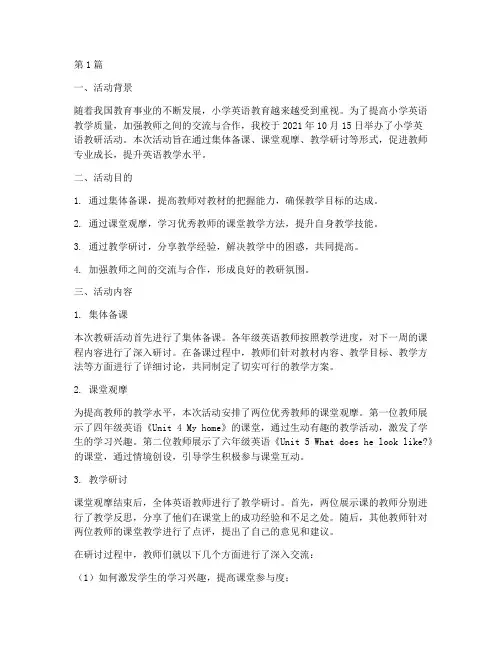
第1篇一、活动背景随着我国教育事业的不断发展,小学英语教育越来越受到重视。
为了提高小学英语教学质量,加强教师之间的交流与合作,我校于2021年10月15日举办了小学英语教研活动。
本次活动旨在通过集体备课、课堂观摩、教学研讨等形式,促进教师专业成长,提升英语教学水平。
二、活动目的1. 通过集体备课,提高教师对教材的把握能力,确保教学目标的达成。
2. 通过课堂观摩,学习优秀教师的课堂教学方法,提升自身教学技能。
3. 通过教学研讨,分享教学经验,解决教学中的困惑,共同提高。
4. 加强教师之间的交流与合作,形成良好的教研氛围。
三、活动内容1. 集体备课本次教研活动首先进行了集体备课。
各年级英语教师按照教学进度,对下一周的课程内容进行了深入研讨。
在备课过程中,教师们针对教材内容、教学目标、教学方法等方面进行了详细讨论,共同制定了切实可行的教学方案。
2. 课堂观摩为提高教师的教学水平,本次活动安排了两位优秀教师的课堂观摩。
第一位教师展示了四年级英语《Unit 4 My home》的课堂,通过生动有趣的教学活动,激发了学生的学习兴趣。
第二位教师展示了六年级英语《Unit 5 What does he look like?》的课堂,通过情境创设,引导学生积极参与课堂互动。
3. 教学研讨课堂观摩结束后,全体英语教师进行了教学研讨。
首先,两位展示课的教师分别进行了教学反思,分享了他们在课堂上的成功经验和不足之处。
随后,其他教师针对两位教师的课堂教学进行了点评,提出了自己的意见和建议。
在研讨过程中,教师们就以下几个方面进行了深入交流:(1)如何激发学生的学习兴趣,提高课堂参与度;(2)如何根据学生的实际情况,调整教学策略,使教学目标得以达成;(3)如何运用多种教学方法,提高英语教学效果;(4)如何关注学生的个体差异,实施分层教学。
4. 教研总结最后,教研组长对本次活动进行了总结。
她指出,本次教研活动取得了圆满成功,达到了预期目标。
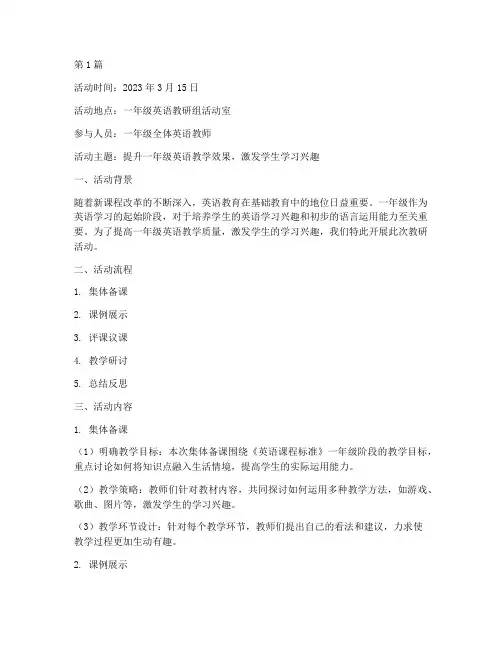
第1篇活动时间:2023年3月15日活动地点:一年级英语教研组活动室参与人员:一年级全体英语教师活动主题:提升一年级英语教学效果,激发学生学习兴趣一、活动背景随着新课程改革的不断深入,英语教育在基础教育中的地位日益重要。
一年级作为英语学习的起始阶段,对于培养学生的英语学习兴趣和初步的语言运用能力至关重要。
为了提高一年级英语教学质量,激发学生的学习兴趣,我们特此开展此次教研活动。
二、活动流程1. 集体备课2. 课例展示3. 评课议课4. 教学研讨5. 总结反思三、活动内容1. 集体备课(1)明确教学目标:本次集体备课围绕《英语课程标准》一年级阶段的教学目标,重点讨论如何将知识点融入生活情境,提高学生的实际运用能力。
(2)教学策略:教师们针对教材内容,共同探讨如何运用多种教学方法,如游戏、歌曲、图片等,激发学生的学习兴趣。
(3)教学环节设计:针对每个教学环节,教师们提出自己的看法和建议,力求使教学过程更加生动有趣。
2. 课例展示(1)课堂展示:由一位教师进行一年级英语示范课展示,全体教师观摩。
(2)课堂亮点:教师展示环节,注重培养学生的听、说、读、写能力,采用生动有趣的教学方法,使学生积极参与课堂活动。
3. 评课议课(1)评课:教师们针对示范课进行点评,指出优点和不足,提出改进建议。
(2)议课:围绕一年级英语教学特点,教师们共同探讨如何提高教学效果,激发学生学习兴趣。
4. 教学研讨(1)教学方法:教师们针对一年级英语教学特点,探讨如何运用游戏、歌曲、图片等教学方法,提高学生的学习兴趣。
(2)教材处理:针对教材内容,教师们共同探讨如何处理教材,使之更加符合学生的认知水平和实际需求。
5. 总结反思(1)总结:本次教研活动取得了圆满成功,教师们在活动中收获颇丰,为今后的教学工作提供了有益的借鉴。
(2)反思:教师们针对本次活动,反思自己在教学中的不足,明确今后努力的方向。
四、活动成果1. 教师们对一年级英语教学有了更深入的认识,明确了教学目标和方法。
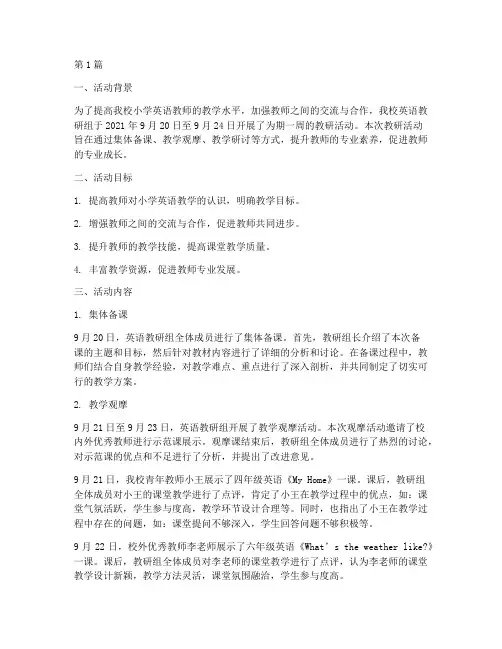
第1篇一、活动背景为了提高我校小学英语教师的教学水平,加强教师之间的交流与合作,我校英语教研组于2021年9月20日至9月24日开展了为期一周的教研活动。
本次教研活动旨在通过集体备课、教学观摩、教学研讨等方式,提升教师的专业素养,促进教师的专业成长。
二、活动目标1. 提高教师对小学英语教学的认识,明确教学目标。
2. 增强教师之间的交流与合作,促进教师共同进步。
3. 提升教师的教学技能,提高课堂教学质量。
4. 丰富教学资源,促进教师专业发展。
三、活动内容1. 集体备课9月20日,英语教研组全体成员进行了集体备课。
首先,教研组长介绍了本次备课的主题和目标,然后针对教材内容进行了详细的分析和讨论。
在备课过程中,教师们结合自身教学经验,对教学难点、重点进行了深入剖析,并共同制定了切实可行的教学方案。
2. 教学观摩9月21日至9月23日,英语教研组开展了教学观摩活动。
本次观摩活动邀请了校内外优秀教师进行示范课展示。
观摩课结束后,教研组全体成员进行了热烈的讨论,对示范课的优点和不足进行了分析,并提出了改进意见。
9月21日,我校青年教师小王展示了四年级英语《My Home》一课。
课后,教研组全体成员对小王的课堂教学进行了点评,肯定了小王在教学过程中的优点,如:课堂气氛活跃,学生参与度高,教学环节设计合理等。
同时,也指出了小王在教学过程中存在的问题,如:课堂提问不够深入,学生回答问题不够积极等。
9月22日,校外优秀教师李老师展示了六年级英语《What’s the weather like?》一课。
课后,教研组全体成员对李老师的课堂教学进行了点评,认为李老师的课堂教学设计新颖,教学方法灵活,课堂氛围融洽,学生参与度高。
9月23日,我校青年教师小李展示了三年级英语《Colors》一课。
课后,教研组全体成员对小李的课堂教学进行了点评,认为小李在教学过程中注重了学生的个体差异,教学方法多样,课堂气氛活跃,但同时也指出了小李在教学过程中存在的问题,如:部分学生参与度不高,教学环节不够紧凑等。
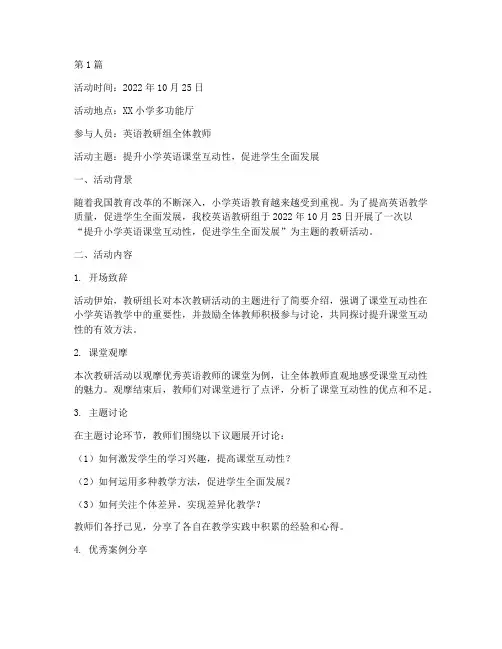
第1篇活动时间:2022年10月25日活动地点:XX小学多功能厅参与人员:英语教研组全体教师活动主题:提升小学英语课堂互动性,促进学生全面发展一、活动背景随着我国教育改革的不断深入,小学英语教育越来越受到重视。
为了提高英语教学质量,促进学生全面发展,我校英语教研组于2022年10月25日开展了一次以“提升小学英语课堂互动性,促进学生全面发展”为主题的教研活动。
二、活动内容1. 开场致辞活动伊始,教研组长对本次教研活动的主题进行了简要介绍,强调了课堂互动性在小学英语教学中的重要性,并鼓励全体教师积极参与讨论,共同探讨提升课堂互动性的有效方法。
2. 课堂观摩本次教研活动以观摩优秀英语教师的课堂为例,让全体教师直观地感受课堂互动性的魅力。
观摩结束后,教师们对课堂进行了点评,分析了课堂互动性的优点和不足。
3. 主题讨论在主题讨论环节,教师们围绕以下议题展开讨论:(1)如何激发学生的学习兴趣,提高课堂互动性?(2)如何运用多种教学方法,促进学生全面发展?(3)如何关注个体差异,实现差异化教学?教师们各抒己见,分享了各自在教学实践中积累的经验和心得。
4. 优秀案例分享在优秀案例分享环节,两位教师分别分享了他们在课堂互动性方面的成功经验。
其中,一位教师通过设计有趣的课堂游戏,激发了学生的学习兴趣,提高了课堂互动性;另一位教师则通过运用多媒体技术,使课堂更加生动有趣,有效提升了学生的英语素养。
5. 总结与反思最后,教研组长对本次教研活动进行了总结,肯定了教师们在课堂互动性方面的努力和成果。
同时,也指出了存在的问题,并提出了改进措施。
三、活动总结本次教研活动取得了圆满成功,达到了预期目标。
以下是活动总结:1. 提高了教师对课堂互动性的认识,明确了提升课堂互动性的重要性。
2. 教师们分享了丰富的教学经验,为今后的教学工作提供了有益的借鉴。
3. 通过观摩优秀案例,教师们对课堂互动性有了更深入的了解,为提高教学质量奠定了基础。
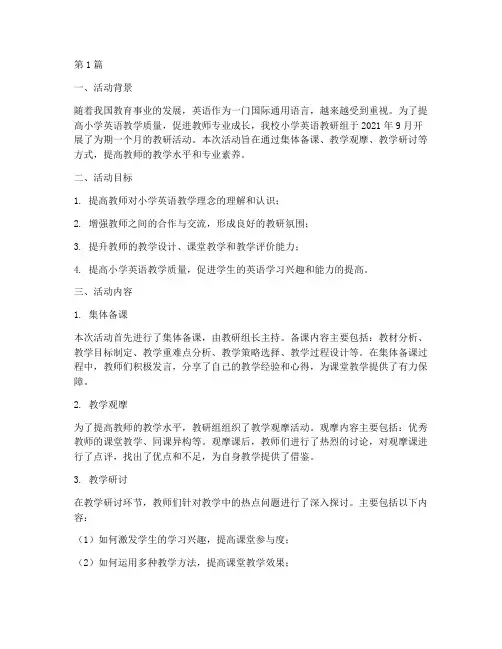
第1篇一、活动背景随着我国教育事业的发展,英语作为一门国际通用语言,越来越受到重视。
为了提高小学英语教学质量,促进教师专业成长,我校小学英语教研组于2021年9月开展了为期一个月的教研活动。
本次活动旨在通过集体备课、教学观摩、教学研讨等方式,提高教师的教学水平和专业素养。
二、活动目标1. 提高教师对小学英语教学理念的理解和认识;2. 增强教师之间的合作与交流,形成良好的教研氛围;3. 提升教师的教学设计、课堂教学和教学评价能力;4. 提高小学英语教学质量,促进学生的英语学习兴趣和能力的提高。
三、活动内容1. 集体备课本次活动首先进行了集体备课,由教研组长主持。
备课内容主要包括:教材分析、教学目标制定、教学重难点分析、教学策略选择、教学过程设计等。
在集体备课过程中,教师们积极发言,分享了自己的教学经验和心得,为课堂教学提供了有力保障。
2. 教学观摩为了提高教师的教学水平,教研组组织了教学观摩活动。
观摩内容主要包括:优秀教师的课堂教学、同课异构等。
观摩课后,教师们进行了热烈的讨论,对观摩课进行了点评,找出了优点和不足,为自身教学提供了借鉴。
3. 教学研讨在教学研讨环节,教师们针对教学中的热点问题进行了深入探讨。
主要包括以下内容:(1)如何激发学生的学习兴趣,提高课堂参与度;(2)如何运用多种教学方法,提高课堂教学效果;(3)如何进行有效的课堂管理,营造良好的学习氛围;(4)如何进行教学评价,提高教学质量。
4. 教学反思在活动最后,教师们进行了教学反思。
通过反思,教师们认识到自己在教学过程中的优点和不足,为今后的教学提供了改进方向。
四、活动成果1. 教师的教学理念得到了更新,对小学英语教学有了更深入的认识;2. 教师之间的合作与交流更加紧密,形成了良好的教研氛围;3. 教师的教学设计、课堂教学和教学评价能力得到了提高;4. 学生的英语学习兴趣和能力得到了提升,小学英语教学质量得到明显提高。
五、活动总结本次小学英语教研组活动取得了圆满成功。
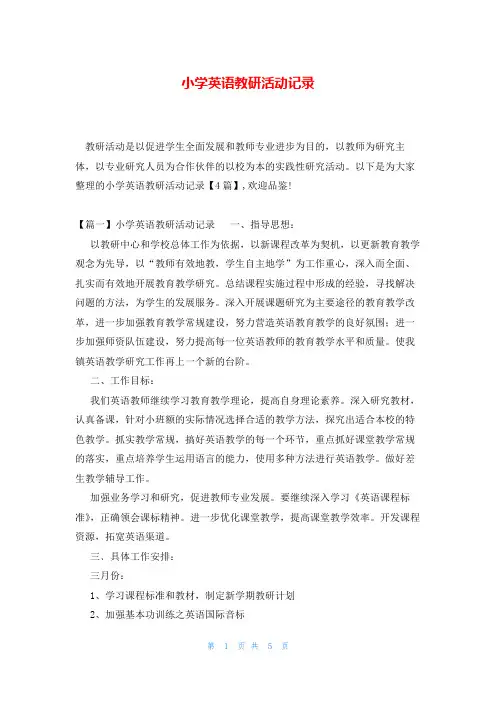
小学英语教研活动记录教研活动是以促进学生全面发展和教师专业进步为目的,以教师为研究主体,以专业研究人员为合作伙伴的以校为本的实践性研究活动。
以下是为大家整理的小学英语教研活动记录【4篇】,欢迎品鉴!【篇一】小学英语教研活动记录一、指导思想:以教研中心和学校总体工作为依据,以新课程改革为契机,以更新教育教学观念为先导,以“教师有效地教,学生自主地学”为工作重心,深入而全面、扎实而有效地开展教育教学研究。
总结课程实施过程中形成的经验,寻找解决问题的方法,为学生的发展服务。
深入开展课题研究为主要途径的教育教学改革,进一步加强教育教学常规建设,努力营造英语教育教学的良好氛围;进一步加强师资队伍建设,努力提高每一位英语教师的教育教学水平和质量。
使我镇英语教学研究工作再上一个新的台阶。
二、工作目标:我们英语教师继续学习教育教学理论,提高自身理论素养。
深入研究教材,认真备课,针对小班额的实际情况选择合适的教学方法,探究出适合本校的特色教学。
抓实教学常规,搞好英语教学的每一个环节,重点抓好课堂教学常规的落实,重点培养学生运用语言的能力,使用多种方法进行英语教学。
做好差生教学辅导工作。
加强业务学习和研究,促进教师专业发展。
要继续深入学习《英语课程标准》,正确领会课标精神。
进一步优化课堂教学,提高课堂教学效率。
开发课程资源,拓宽英语渠道。
三﹑具体工作安排:三月份:1、学习课程标准和教材,制定新学期教研计划2、加强基本功训练之英语国际音标四月份:教师基本功训练之课堂用语五月份;集体备课五年级L5WherstheGiftShop?六月份:1、研讨如何有效培养学生口语交际能力。
2、做好各年级英语期末复习检测工作。
(重点毕业班)【篇二】小学英语教研活动记录一、教研活动的目的及意义1、目的:在教育方针的正确指引下,探索符合我校学情教情的小学英语学习规律,全面提高小学英语教学质量,落实素质教育的实施。
2、意义:通过教研活动,搭建英语教师展示才华和经验成果的舞台,学习交流分享经验的平台。
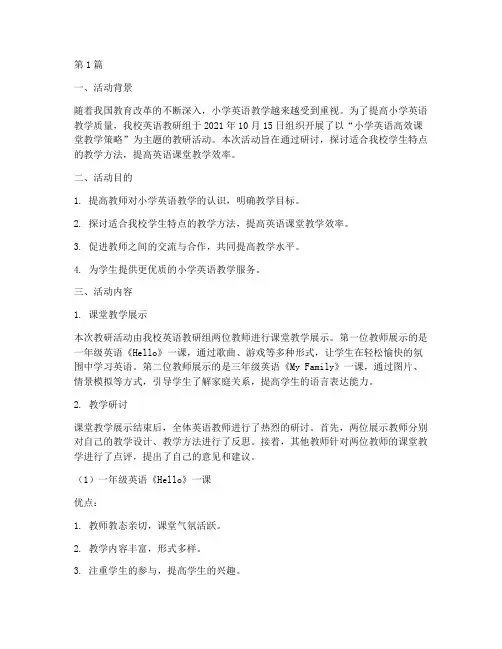
一、活动背景随着我国教育改革的不断深入,小学英语教学越来越受到重视。
为了提高小学英语教学质量,我校英语教研组于2021年10月15日组织开展了以“小学英语高效课堂教学策略”为主题的教研活动。
本次活动旨在通过研讨,探讨适合我校学生特点的教学方法,提高英语课堂教学效率。
二、活动目的1. 提高教师对小学英语教学的认识,明确教学目标。
2. 探讨适合我校学生特点的教学方法,提高英语课堂教学效率。
3. 促进教师之间的交流与合作,共同提高教学水平。
4. 为学生提供更优质的小学英语教学服务。
三、活动内容1. 课堂教学展示本次教研活动由我校英语教研组两位教师进行课堂教学展示。
第一位教师展示的是一年级英语《Hello》一课,通过歌曲、游戏等多种形式,让学生在轻松愉快的氛围中学习英语。
第二位教师展示的是三年级英语《My Family》一课,通过图片、情景模拟等方式,引导学生了解家庭关系,提高学生的语言表达能力。
2. 教学研讨课堂教学展示结束后,全体英语教师进行了热烈的研讨。
首先,两位展示教师分别对自己的教学设计、教学方法进行了反思。
接着,其他教师针对两位教师的课堂教学进行了点评,提出了自己的意见和建议。
(1)一年级英语《Hello》一课优点:1. 教师教态亲切,课堂气氛活跃。
2. 教学内容丰富,形式多样。
3. 注重学生的参与,提高学生的兴趣。
1. 部分教学环节时间分配不合理。
2. 对学生的评价方式单一。
(2)三年级英语《My Family》一课优点:1. 教学目标明确,重难点突出。
2. 教学方法灵活,贴近学生实际。
3. 注重培养学生的语言表达能力。
不足:1. 部分学生参与度不高。
2. 教学过程中,教师对学生的评价不够具体。
3. 部分教学内容与学生的实际生活联系不够紧密。
3. 教学经验分享在研讨过程中,部分有经验的教师分享了他们在小学英语教学中的心得体会。
他们认为,要上好一节英语课,首先要了解学生的需求,关注学生的个体差异;其次,要注重教学方法,提高课堂效率;最后,要加强与学生的互动,激发学生的学习兴趣。
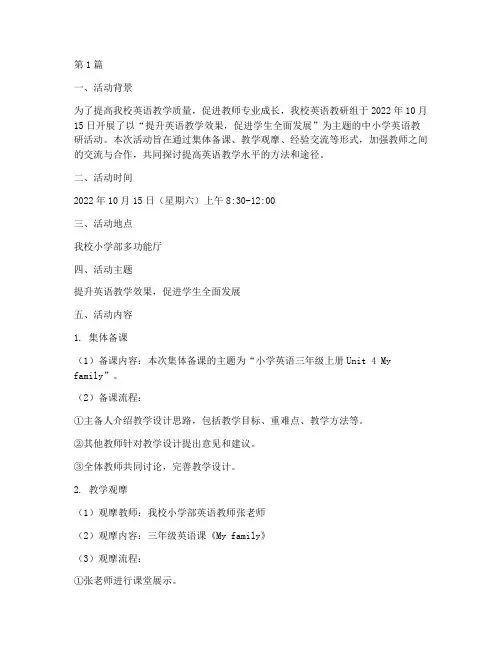
第1篇一、活动背景为了提高我校英语教学质量,促进教师专业成长,我校英语教研组于2022年10月15日开展了以“提升英语教学效果,促进学生全面发展”为主题的中小学英语教研活动。
本次活动旨在通过集体备课、教学观摩、经验交流等形式,加强教师之间的交流与合作,共同探讨提高英语教学水平的方法和途径。
二、活动时间2022年10月15日(星期六)上午8:30-12:00三、活动地点我校小学部多功能厅四、活动主题提升英语教学效果,促进学生全面发展五、活动内容1. 集体备课(1)备课内容:本次集体备课的主题为“小学英语三年级上册Unit 4 My family”。
(2)备课流程:①主备人介绍教学设计思路,包括教学目标、重难点、教学方法等。
②其他教师针对教学设计提出意见和建议。
③全体教师共同讨论,完善教学设计。
2. 教学观摩(1)观摩教师:我校小学部英语教师张老师(2)观摩内容:三年级英语课《My family》(3)观摩流程:①张老师进行课堂展示。
②其他教师观摩并记录教学过程中的亮点和不足。
3. 经验交流(1)交流主题:如何提高英语课堂效率(2)交流流程:①张老师分享自己的教学经验。
②其他教师结合自身教学实际,分享提高英语课堂效率的方法。
③全体教师共同讨论,总结提高英语课堂效率的共性方法。
六、活动总结1. 集体备课环节,全体教师积极参与,共同完善教学设计,为提高教学质量奠定了基础。
2. 教学观摩环节,张老师的课堂展示充分体现了以学生为主体的教学理念,激发了学生的学习兴趣,值得我们学习。
3. 经验交流环节,教师们畅所欲言,分享了提高英语课堂效率的方法,为今后的教学提供了有益的借鉴。
4. 活动结束后,教研组长对本次活动进行了总结,并对今后的英语教学工作提出了要求。
七、活动成果1. 教师们对小学英语三年级上册Unit 4 My family的教学设计有了更深入的了解。
2. 教师们掌握了提高英语课堂效率的方法,为今后的教学工作提供了有力支持。
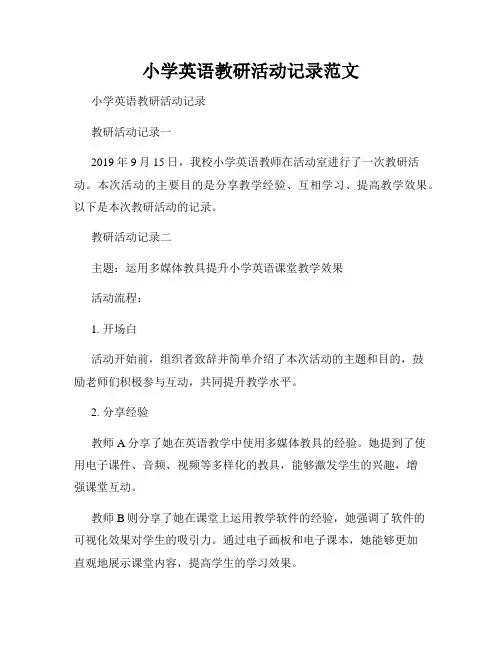
小学英语教研活动记录范文小学英语教研活动记录教研活动记录一2019年9月15日,我校小学英语教师在活动室进行了一次教研活动。
本次活动的主要目的是分享教学经验、互相学习、提高教学效果。
以下是本次教研活动的记录。
教研活动记录二主题:运用多媒体教具提升小学英语课堂教学效果活动流程:1. 开场白活动开始前,组织者致辞并简单介绍了本次活动的主题和目的,鼓励老师们积极参与互动,共同提升教学水平。
2. 分享经验教师A分享了她在英语教学中使用多媒体教具的经验。
她提到了使用电子课件、音频、视频等多样化的教具,能够激发学生的兴趣,增强课堂互动。
教师B则分享了她在课堂上运用教学软件的经验,她强调了软件的可视化效果对学生的吸引力。
通过电子画板和电子课本,她能够更加直观地展示课堂内容,提高学生的学习效果。
3. 分组讨论在分享经验环节结束后,老师们分成小组进行讨论。
每个小组选择一位代表分享他们的观点和经验。
一组的代表指出,多媒体教具可以激发学生的学习兴趣,提高课堂效率。
另一组的代表提到,教师要根据学生的不同需求选择合适的教具,确保课堂教学效果最大化。
4. 实战演练本次活动设置了实战演练环节。
教师C上台展示了她精心准备的小学英语课堂教学案例。
她运用了多媒体教具,包括图片、视频和音频等,帮助学生更好地理解和记忆课堂内容。
5. 经验总结在活动的最后阶段,教师们进行了经验总结。
大家一致认为,多媒体教具的使用能够增加课堂的趣味性和互动性,提高学生的学习积极性。
教研活动记录三结语通过本次教研活动,我们不仅学习到了许多新的教学方法和技巧,也发现了自己在教学中的不足之处。
在今后的教学中,我们将更加注重运用多媒体教具,提高课堂教学效果。
同时,我们也会继续参加教研活动,与更多的教师进行交流,不断进步。
小学英语教研活动记录,上面是本次活动的详细记录。
通过此次教研活动,老师们积极互相学习,并分享他们在运用多媒体教具方面的经验和心得。
这将有助于提高他们的教学水平,为学生提供更好的英语学习环境。
第1篇一、活动背景为了提高我校小学英语教学质量,加强教师之间的交流与合作,促进教师专业成长,我校英语教研组于2022年3月15日开展了主题为“小学英语课堂互动策略探讨”的教研活动。
本次活动旨在通过集体备课、课堂观摩、教学反思等形式,探讨如何提高小学英语课堂互动性,激发学生的学习兴趣,提升英语教学效果。
二、活动目标1. 通过集体备课,提升教师对小学英语课堂互动策略的认识。
2. 通过课堂观摩,学习优秀教师的课堂互动经验。
3. 通过教学反思,总结自身教学中的不足,提出改进措施。
三、活动内容1. 集体备课活动开始,英语教研组全体成员齐聚会议室,共同进行集体备课。
本次备课的主题为“Unit 4 My Home”。
备课过程中,教师们针对教材内容、教学目标、教学重难点、教学方法等方面进行了深入探讨。
(1)教材分析:教师们对教材内容进行了详细分析,明确了教学目标,确定了教学重难点。
(2)教学目标:通过本节课的学习,学生能够掌握以下知识:- 说出家庭成员的英文表达;- 理解并运用表示地点的词汇;- 能够进行简单的家庭介绍。
(3)教学重难点:重点为家庭成员的英文表达和表示地点的词汇;难点为家庭介绍的口语表达。
(4)教学方法:教师们结合教材内容和教学目标,共同探讨了以下教学方法:- 情境教学法:通过创设真实情境,让学生在情境中学习;- 任务驱动法:通过设计任务,引导学生主动参与课堂互动;- 合作学习法:通过小组合作,培养学生的团队协作能力。
2. 课堂观摩集体备课结束后,教研组选派了两位教师进行课堂观摩。
观摩课的主题为“Unit 4 My Home”。
两位教师分别展示了不同风格的课堂互动策略。
(1)教师A的课堂:教师A以情境教学法为主,通过多媒体展示家庭成员图片,引导学生说出家庭成员的英文表达。
在课堂互动过程中,教师A注重学生的口语表达,鼓励学生大胆开口说英语。
(2)教师B的课堂:教师B以任务驱动法为主,设计了“介绍我的家庭”的任务,让学生在完成任务的过程中,运用所学知识进行口语表达。
第1篇活动时间:2023年4月15日,星期五,下午2:00-5:00活动地点:学校多功能厅参与人员:英语教研组全体教师主持人:张晓芳老师活动主题:探讨小学英语课堂有效教学策略活动记录:一、活动开场张晓芳老师首先对本次活动进行了简要介绍,强调了本次教研活动的重要性和目的,即通过集体讨论,提升教师的教学水平,提高英语课堂的教学效果。
二、活动流程1. 经验分享活动伊始,李明老师分享了他在课堂教学中的一些成功经验。
他指出,课堂氛围的营造对于学生的学习兴趣至关重要。
他通过设计富有创意的教学活动,如角色扮演、小组讨论等,激发了学生的学习热情。
2. 案例分析接着,王丽老师分享了一个课堂案例。
在分析这个案例时,她强调了教师应关注学生的个体差异,因材施教。
她通过观察学生的反应,及时调整教学策略,确保每个学生都能在课堂上有所收获。
3. 小组讨论随后,全体教师分为三个小组,针对以下问题进行讨论:(1)如何提高学生的英语听说能力?(2)如何有效利用课堂时间,提高教学效率?(3)如何激发学生的学习兴趣,培养他们的自主学习能力?在讨论过程中,老师们各抒己见,分享了自己的教学心得。
经过一番热烈的讨论,各组分别提出了以下建议:(1)提高学生的英语听说能力:- 创设真实的语言环境,鼓励学生在课堂上多开口说英语;- 开展丰富多彩的课外活动,如英语角、英语演讲比赛等;- 利用多媒体技术,如视频、音频等,丰富教学内容。
(2)有效利用课堂时间,提高教学效率:- 制定详细的教学计划,合理安排教学内容;- 优化教学环节,如减少不必要的讲解,增加互动环节;- 关注学生的反馈,及时调整教学策略。
(3)激发学生的学习兴趣,培养自主学习能力:- 创设有趣的教学情境,让学生在轻松愉快的氛围中学习;- 鼓励学生参与课堂活动,发挥他们的主观能动性;- 培养学生的自我管理能力,让他们学会自主学习。
4. 总结与反思最后,张晓芳老师对本次教研活动进行了总结。
她肯定了老师们在讨论中的积极参与和提出的宝贵建议,并强调以下几点:- 教师应不断提高自身的专业素养,关注学生的学习需求;- 注重课堂氛围的营造,激发学生的学习兴趣;- 创新教学方法,提高教学效率。
第1篇Date: [Date of the Activity]Location: [School Name] Primary Section, [Room Number]Duration: [Start Time] to [End Time]Participants:- [Teacher's Name] (Activity Coordinator)- [Teacher 1's Name]- [Teacher 2's Name]- [Teacher 3's Name]- [Teacher 4's Name]- [Teacher 5's Name]- [Support Staff 1's Name]- [Support Staff 2's Name]Objective:The primary objective of this教研活动 was to enhance the teaching and learning experience at [School Name] Primary Section by exploring innovative teaching methods, sharing best practices, and addressing common challenges faced by teachers in the classroom.Agenda:1. Opening Remarks and Introduction (9:00 AM - 9:15 AM)- [Teacher's Name] welcomed all participants and introduced the agenda for the day.- A brief overview of the purpose and expected outcomes of the activity was provided.2. Workshop on Interactive Teaching Techniques (9:15 AM - 10:30 AM)- The workshop focused on incorporating interactive teaching techniques into the classroom.- Participants engaged in a series of activities to experience different methods such as group discussions, role-playing, and multimedia presentations.- [Teacher 1's Name] led the session, sharing examples of successful implementations from their own classes.3. Break (10:30 AM - 10:45 AM)- A short break was provided for participants to refresh and network with each other.4. Case Study Analysis (10:45 AM - 12:00 PM)- Participants were divided into small groups to analyze case studies of challenging classroom situations.- Each group discussed potential solutions and strategies to address the issues presented in the case studies.- The groups then presented their findings to the larger group for feedback and discussion.5. Lunch Break (12:00 PM - 1:00 PM)- Participants enjoyed a lunch break, which also served as an opportunity for informal discussions.6. Workshop on Differentiated Instruction (1:00 PM - 2:15 PM)- The workshop aimed to explore differentiated instruction techniques to cater to diverse learning styles and abilities.- Participants engaged in activities that required them to create differentiated lesson plans for a given topic.- [Teacher 2's Name] facilitated the session, providing insights and examples from their own teaching experience.7. Break (2:15 PM - 2:30 PM)- Another short break was provided for participants to rest and prepare for the final session.8. Panel Discussion on Student Engagement (2:30 PM - 3:45 PM)- A panel discussion was held to explore effective strategies for increasing student engagement.- The panel included [Teacher 3's Name], [Teacher 4's Name], and [Teacher 5's Name], who shared their experiences and insights.- The discussion was moderated by [Teacher's Name] and included questions from the audience.9. Closing Remarks and Feedback (3:45 PM - 4:00 PM)- [Teacher's Name] provided closing remarks, summarizing the key points discussed during the activity.- Participants were invited to provide feedback on the day's events, which will be used to improve future教研活动.Reflections:- The workshop on interactive teaching techniques was particularly beneficial, as it provided practical strategies that can be easily implemented in the classroom.- The case study analysis was an excellent opportunity for collaborative learning, as participants shared their insights and learned from each other's experiences.- The workshop on differentiated instruction opened up new perspectives on how to cater to the diverse needs of students.- The panel discussion on student engagement was insightful and provided actionable advice for improving classroom dynamics.Action Plan:- Implement interactive teaching techniques in the classroom.- Develop differentiated lesson plans for diverse learning styles.- Regularly review and update teaching materials to enhance student engagement.- Continue to participate in and organize教研活动 to foster a cultureof continuous improvement.Conclusion:The教研活动 at [School Name] Primary Section was a resounding success, providing valuable insights and practical tools for teachers to enhance their teaching practices. The collaborative spirit and willingness to learn from each other were evident throughout the day, and the participants left with a renewed sense of motivation and a clearervision for their classrooms.第2篇Date: [Insert Date]Location: [Insert Location]Participants: [List of Participants]Facilitator: [Name of Facilitator]---IntroductionThe purpose of this教研活动 (Research and Development Activity) was to enhance the quality of English language teaching in primary schools. The activity focused on exploring innovative teaching methods, discussing best practices, and sharing experiences among educators. This record aims to capture the essence of the event, highlighting key discussions, activities, and outcomes.---I. Opening Remarks and Introduction to the TopicThe session began with a warm welcome from the facilitator, who introduced the objectives of the教研活动. The focus was on integrating technology into English language instruction to make learning more engaging and effective for primary school students.II. Panel Discussion: The Impact of Technology on Primary English EducationA panel of experts from various educational institutions engaged in a lively discussion on the topic. The following points were highlighted:1. Enhanced Engagement: Technology can make learning more interactive and engaging for students, fostering a positive learning environment.2. Adaptability: Digital tools can cater to diverse learning styles and needs, providing personalized learning experiences.3. Global Access: Technology enables students to connect with peers worldwide, broadening their cultural perspectives and language skills.4. Teacher Support: Educators can use technology to monitor student progress, provide timely feedback, and develop targeted interventions.---III. Workshops and Interactive SessionsThe participants were divided into small groups to engage in workshops and interactive sessions. Here are some of the activities conducted:1. Interactive Whiteboard Techniques: Participants learned how to effectively use interactive whiteboards to facilitate group discussions and collaborative learning.2. Mobile Apps for Language Learning: The session explored various mobile applications that can be used to teach English, such as Duolingo, Rosetta Stone, and HelloTalk.3. Flipped Classroom Approach: Educators discussed the benefits of the flipped classroom model, where students learn new concepts at homethrough videos and readings, and classroom time is dedicated to practice and discussion.---IV. Case Studies and Best PracticesParticipants shared case studies and best practices from their own experiences. Some notable examples included:1. Integrating Storytelling: A teacher from a local primary school described how she uses storytelling to teach grammar and vocabulary, making the learning process more enjoyable and memorable.2. Collaborative Projects: Another educator shared her experience of organizing group projects that required students to research and present information in English, enhancing their research and presentation skills.3. Parental Involvement: A teacher highlighted the importance of involving parents in the learning process, suggesting regular communication through emails, newsletters, and parent-teacher meetings.---V. Group Reflection and FeedbackEach group reflected on the activities and shared their feedback. The following points were highlighted:1. Improved Student Engagement: Participants observed that integrating technology and interactive activities significantly increased student engagement and motivation.2. Continuous Professional Development: The need for ongoing professional development to keep up with the latest teaching trends and technologies was emphasized.3. Collaboration and Sharing: The importance of collaboration among educators to share best practices and support each other in their teaching endeavors was underlined.---VI. Closing Remarks and Next StepsThe facilitator summarized the key takeaways from the教研活动 and outlined the next steps. These included:1. Follow-up Workshops: Organizing follow-up workshops to delve deeper into specific topics discussed during the event.2. Resource Sharing: Creating a platform for educators to share resources, such as lesson plans, activities, and digital tools.3. Continuous Monitoring: Establishing a system to monitor the implementation of new teaching methods and technologies in classrooms.---ConclusionThe教研活动 in English primary education proved to be a valuable opportunity for educators to explore innovative teaching methods, share best practices, and collaborate to enhance the quality of English language instruction. By embracing technology and fostering a collaborative environment, educators can create a more engaging and effective learning experience for primary school students.第3篇Date: March 15, 2023Location: XYZ Elementary School, Classroom 3Participants:1. Teacher: Miss Alice Zhang2. Subject Matter Expert: Mr. John Smith3. Observers: Ms. Lily Wang, Mr. Michael Chen4. Students: Class 3A, 25 studentsObjective:The objective of this research and development activity was to explore and implement innovative teaching methods to enhance students' learning experiences and promote their critical thinking skills.Agenda:I. Introduction1. Miss Alice Zhang welcomed all participants and introduced the purpose of the activity.2. Mr. John Smith, the subject matter expert, shared his insights on effective teaching strategies.II. Activity Demonstration1. Miss Alice Zhang began the activity by dividing the class into small groups of five students each.2. Each group was given a set of objects (e.g., blocks, balls, cards) and instructed to create a story using these objects.3. The students were encouraged to think creatively and communicatetheir ideas with their group members.III. Implementation of Innovative Teaching Methods1. Miss Alice Zhang used the "Think-Pair-Share" technique to engage students in active learning.a. She first asked the students to think individually about a question related to the story they had created.b. Then, they were paired with a partner to discuss their thoughts and share them with the class.c. Finally, the whole class discussed the answers and different perspectives.2. The teacher also incorporated "Problem-Based Learning" (PBL) into the activity.a. Students were given a problem to solve, such as "How can we usethe objects to create a scene from a famous story?"b. They worked collaboratively to find solutions and present their findings to the class.IV. Observations and Feedback1. Ms. Lily Wang and Mr. Michael Chen observed the students'participation and progress during the activity.2. They noted the following observations:a. Students were highly engaged and showed enthusiasm in the activity.b. The groups worked well together, displaying effective communication and collaboration skills.c. The students were able to think critically and solve problems independently.V. Reflection and Discussion1. After the activity, the teacher, subject matter expert, and observers gathered to discuss the outcomes and feedback.2. Key points of the discussion included:a. The innovative teaching methods were well-received by the students, leading to higher engagement and improved learning outcomes.b. The "Think-Pair-Share" and "Problem-Based Learning" techniques were effective in promoting critical thinking and teamwork among students.c. The teacher's role as a facilitator was crucial in creating a supportive and interactive learning environment.VI. Recommendations for Future Activities1. Continue to incorporate innovative teaching methods into regular classroom activities.2. Provide more opportunities for students to work in groups and collaborate on projects.3. Encourage students to think critically and solve problems independently.4. Conduct follow-up assessments to monitor the progress and effectiveness of the implemented strategies.Conclusion:The research and development activity at XYZ Elementary School was a success, as it showcased the potential of innovative teaching methods in enhancing students' learning experiences. The participation of students, along with the valuable insights from the subject matter expert and observers, provided a solid foundation for future improvements in teaching and learning practices. By continuously exploring newstrategies and techniques, we aim to create a more engaging andeffective learning environment for all students.。
第1篇Date: [Insert Date]Location: [Insert Venue]Participants: [List of Participants]Introduction:The English Research and Development Activity aimed to enhance the teaching and learning of English in our primary school. The session brought together teachers, educationalists, and school administrators to discuss effective strategies, share experiences, and explore innovative approaches to teaching English. The following is a detailed record ofthe activities and discussions that took place during the session.---I. Opening Remarks and Welcome AddressThe session commenced with a warm welcome address by the school principal, who emphasized the importance of English language educationin the globalized world. He highlighted the school’s commitment to providing a high-quality English learning environment and expressed his hope that the session would be fruitful and insightful.II. Keynote Presentation: “Innovative Approaches to Primary English Teaching”The keynote presentation was delivered by Dr. [Name], a renowned educationalist and expert in primary English education. Dr. [Name] spoke about the latest trends and research findings in the field, emphasizing the importance of a child-centered approach and the integration of technology in language learning.III. Workshop: “Engaging Primary Students in English Language Learning”The workshop focused on practical strategies to engage primary students in English language learning. Participants engaged in various activities,including role-playing, group discussions, and interactive games. Here are some key takeaways from the workshop:1. Interactive Storytelling: Using interactive storytelling techniques to make lessons more engaging and interactive.2. Music and Movement: Incorporating music and movement into lessons to enhance vocabulary acquisition and pronunciation.3. Technology Integration: Utilizing educational apps and online resources to provide interactive and personalized learning experiences.4. Collaborative Learning: Encouraging students to work in pairs or groups to practice speaking and listening skills.IV. Case Study Presentation: “Success Stories in Primary English Teaching”Two teachers from our school presented case studies showcasing successful approaches to teaching English in the primary grades. Thefirst case study focused on the use of project-based learning to enhance reading and writing skills, while the second highlighted the benefits of flipped classrooms in improving student engagement and achievement.V. Panel Discussion: “Challenge s and Solutions in Primary English Education”A panel discussion followed, featuring teachers, educationalists, and school administrators. The panelists addressed various challenges faced in primary English education, such as limited resources, lack of teacher training, and diverse student backgrounds. Here are some key points raised during the discussion:1. Teacher Training: The need for continuous professional development to keep teachers updated with the latest teaching methodologies and resources.2. Resource Allocation: Ensuring that schools have access to adequate resources, including textbooks, technology, and learning materials.3. Student Diversity: Tailoring teaching strategies to accommodate diverse student needs and learning styles.4. Parental Involvement: Encouraging parental involvement to support their children’s English language learning at home.VI. Roundtable Discussions: “Brainstorming Innovative Ideas”Participants were divided into small groups to brainstorm innovative ideas for improving primary English education. The groups discussed a variety of topics, including:1. Creating a Language-rich Environment: Integrating English into other subjects and daily activities to provide students with moreopportunities to practice the language.2. Collaboration with Local Communities: Partnering with local businesses and organizations to provide real-life language learning experiences.3. Developing a School-wide English Policy: Establishing clear goals and expectations for English language learning across the school.VII. Closing Remarks and Action PlanThe session concluded with a closing address by the school principal, who thanked all participants for their contributions and commitment to improving primary English education. He outlined an action plan to implement the ideas and strategies discussed during the session, including:1. Professional Development Workshops: Organizing regular workshops for teachers to enhance their skills in English language teaching.2. Resource Development: Collaborating with educational institutions and organizations to develop relevant learning materials.3. Parental Engagement Programs: Implementing initiatives to involve parents in their children’s English language learning.Conclusion:The English Research and Development Activity was a resounding success, providing valuable insights and practical strategies for enhancing the teaching and learning of English in our primary school. The session fostered collaboration, creativity, and a shared commitment to improving the quality of English education for our students. We look forward to implementing the action plan and continuing our journey towards excellence in primary English education.第2篇活动时间:2023年4月15日活动地点:小学英语教研活动室参与人员:全体小学英语教师活动主题:提升小学英语课堂互动性与趣味性一、活动背景随着新课程改革的深入推进,小学英语教学逐渐从传统的知识传授转向注重学生综合能力的培养。
小学英语教研活动记录(5篇)第一篇:小学英语教研活动记录主备人:c参加人员:英语组全体成员教研时间:xxxx.6.21教研主题:采用多种形式组织低年级课堂纪律,以保证课堂效率教研内容:当我开始接手低年级时,最令我头疼的就是课堂纪律难以控制,60多个学生中只要有几个同学说话或插嘴就会扰乱整个课堂,有时任凭你喊破喉咙去呵斥他们,还是不管用,真可谓是按下葫芦,瓢起来啊。
后来,我通过和一些老教师交流,再加上不断地查阅相关资料,我总结了以下几个可行的方法。
1、表扬引导法当课堂秩序混乱时,教师不必批评那些不好的学生,而是迅速选出一个认真听讲的学生加以表扬,树立榜样,号召其他同学向其学习,这样便会出现一种“演戏效应”,受表扬的同学由于得到了满足会更好地充当榜样,其他同学也会为争得老师的表扬去努力按照老师的要求去做。
2、竞赛法教师在讲课前,可以向学生宣布在课堂上要开展争夺“小红旗”的竞赛活动,然后把全班同学分成若干组,要求每组同学必须认真听讲,积极回答问题,遵守课堂纪律,下课时评出最好的小组,每人授予一枚“小红旗”,这样不仅调动学生的学习积极性,而且还会保持良好的课堂纪律,使课堂活动不乱。
3、情趣调节法当老师发现部分学生不再注意听老师讲课,搞小动作、和同桌说话,或者是精神不振,感觉疲劳等现象出现,这时教师应及时采用富有情趣的活动加以调节,避免因过渡疲劳而降低学习效果,如我经常让同学们做一些英语热身操,如“one finger, one finger, turn, turn,turn, turn a worm, climb, climb.two fingers, two fingers, turn, turn, turn, turn a rabbit,jump,jump….”教研要点:a老师:没有惩罚的教育是不完整的教育, 批评和表扬在教育中同样重要,缺少了其中一面的教育是一种缺失的教育,所以在教育中面对那些屡教不改,表扬奖励对其不生效的顽皮小孩,我们可以适当批评惩罚,给他一些小教训,让他们在小教训中反思和学会约束自身不良的行为。
第1篇一、活动背景为了提高小学英语教学质量,促进教师专业成长,加强教师之间的交流与合作,本学期我们将开展一系列的英语教研活动。
以下为小学英语教研活动行事历,旨在明确活动时间、主题、参与人员及活动内容。
二、活动目标1. 提高英语教师的教学水平和专业素养。
2. 促进教师之间的交流与合作,共同探讨教学方法。
3. 增强学生的英语学习兴趣,提高英语学习效果。
4. 推动学校英语教育教学工作的全面发展。
三、活动安排1. 活动时间:本学期每周五下午第三节课2. 活动地点:学校多功能厅3. 活动主题及内容:(一)第一周(第1-2周)主题:英语课堂教学常规培训内容:1. 介绍英语课堂教学的基本原则和方法。
2. 分析英语课堂教学中的常见问题及解决策略。
3. 分享优秀英语教师的课堂教学经验。
(二)第二周(第3-4周)主题:英语课堂教学技能提升内容:1. 讲解英语课堂活动设计原则及技巧。
2. 分析英语课堂提问技巧,提高课堂互动性。
3. 分享英语课堂游戏教学经验,激发学生学习兴趣。
(三)第三周(第5-6周)主题:英语教学资源整合与应用内容:1. 介绍英语教学资源种类及获取途径。
2. 分析如何有效利用英语教学资源,提高教学效果。
3. 分享优秀英语教师的资源整合与应用经验。
(四)第四周(第7-8周)主题:英语课堂教学评价与反思内容:1. 介绍英语课堂教学评价方法及工具。
2. 分析如何进行英语课堂教学反思,提高教学质量。
3. 分享优秀英语教师的课堂教学评价与反思经验。
(五)第五周(第9-10周)主题:英语口语教学探讨内容:1. 介绍英语口语教学的重要性及方法。
2. 分析如何提高学生的英语口语表达能力。
3. 分享优秀英语教师的口语教学经验。
(六)第六周(第11-12周)主题:英语写作教学研究内容:1. 介绍英语写作教学的基本原则和方法。
2. 分析如何提高学生的英语写作能力。
3. 分享优秀英语教师的写作教学经验。
(七)第七周(第13-14周)主题:英语教学案例分析内容:1. 分享优秀英语教师的课堂教学案例。